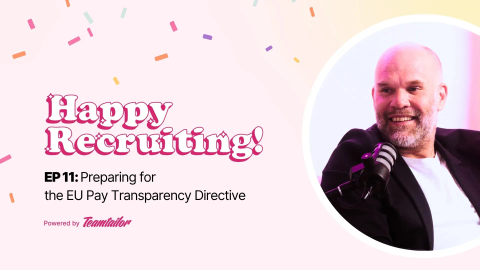Preparing for the EU Pay Transparency Directive

We're joined by Daniel Edenholm, founder of Sysarb to break down the upcoming EU Pay Transparency Directive and how it will reshape the way we look at salaries. This episode covers what the 2026 Directive means for recruiters and HR teams alike, and how to prepare.

Valentina Behrouzi
I'm Val, one of the Marketing Managers here at Teamtailor, responsible for our Global marketing. I love talking about candidate experience and how we can strive to make hiring more inclusive.
The EU Pay Transparency Directive represents a significant shift in the European employment landscape. It’s coming into effect in 2026, but it’s important for companies to be prepared in advance. We spoke with Daniel Edenholm, founder of Sysarb to find out what this new directive means for recruitment.
What Is the EU Pay Transparency Directive?
The EU Pay Transparency Directive has been created to decrease the significant gender pay gap. Taking effect by June 5th 2026, it will enforce transparency in how salaries are structured and communicated internally and externally.
Some of the changes that come with the Directive:
- Employers will need to publicly present average pay gaps
- Job ads are required to include salary ranges
- Employers must develop structured salary bands to justify pay levels
- Employers will no longer be allowed to ask candidates about salary history.
So, when you as an employer present a job ad, you have to describe the pay range. And that's a new step for many countries
What does this mean for recruitment?
The changes coming into place will have a significant impact on the way we hire. Some of the biggest changes employers and hiring teams need to prepare for are:
- Salary transparency begins even earlier: Salary ranges must be structured, justified and clear before publishing roles, as they will need to be visible within the job description.
- More fairness for candidates: Dynamics for salary negotiation will change significantly, as you’ll only be able to ask candidates about their expectations, not what they’ve previously earned.
- A shift in candidate experience: More transparency and honesty from the beginning will allow candidates to better choose roles which align with their expectations.
Developing a job architecture
Daniel explains that the same role can have different levels, meaning you might have different pay ranges for the same role because of the responsibilities.
This is why it’s so important to not just look up the statistics of a job title, but to actually put in the research to develop a structure beforehand. Your team needs to work on the job architecture for different job levels, roles and responsibilities and ensure everyone is on the same page.
Having a solid job architecture in place will be essential for explaining why someone is at a certain salary level, justifying the differences between salaries and setting expectations with candidates and employees from the very beginning.
Will this Directive lead to a bigger cultural shift?
Beyond the policies and the processes, Daniel thinks this directive will likely reshape workplace culture as a whole. Forcing us to talk about salaries can lead to creating transparency in other areas of the business as well.
Future conversations about pay will be fuelled by data and expectations for fairness and consistency. Employees will have access to more information about their colleague’s pay and transparent, evidence-based conversations.
Key takeaways
Prepare: One of the biggest things you can do to make sure you’re ready for the EU Pay Transparency Directive is to start preparing now if you haven’t already. Don’t wait for the rush of next year and start organizing your architecture.
Over-communicate: Once you have your job architecture and structures sorted, make sure everyone is on the same page. Your candidate experience could be affected by inconsistent messaging from your team.
Educate: Your TA teams and hiring managers will be on the frontlines of answering questions from candidates. Ensure you’ve given them the tools and training they need to support transparent conversations.
To listen to the rest of the episode and learn more on the EU Pay Transparency Directive, check out the episode on your preferred platform below!
![]()
5 ways to improve your job postings
Your job posting is often the first impression your candidates are going to get of your company. We’ll go through a few quick and easy things you can do to improve your job postings and convert more candidates.
![]()
Mastering tech recruitment
In our latest episode of Happy Recruiting, we spoke with Diana Rose, Talent Acquisition Specialist at Boozt, for an in-depth conversation on tech recruiting. Why is there such a high demand, why is tech recruiting so unique and where does candidate experience come in?
![]()
The perfect phone screening
There are so many ways to screen candidates, both new and old, but the classic phone screen has managed to stand the test of time. We sat down with Kelly Davis, to dive deeper into why it has remained such a pivotal step in the hiring process.


